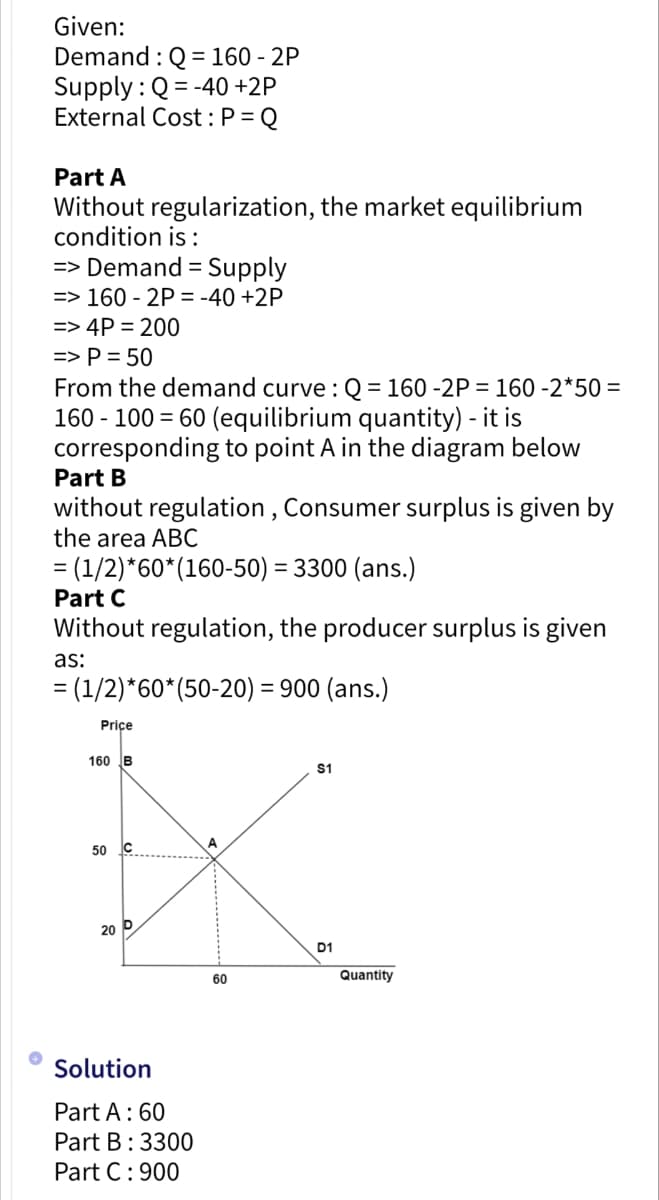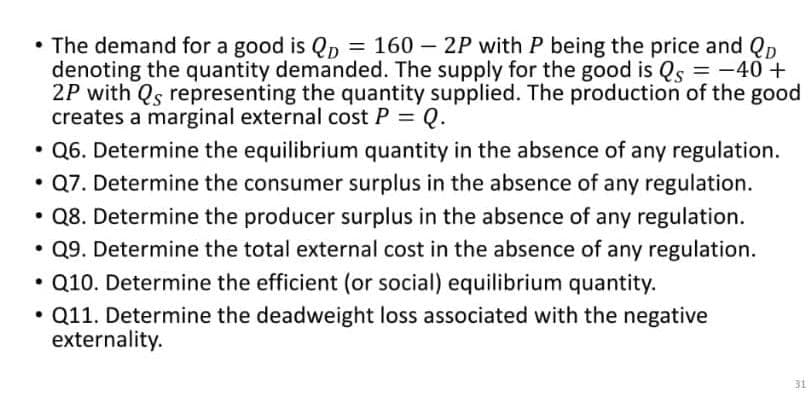• The demand for a good is QD = 160-2P with P being the price and QD denoting the quantity demanded. The supply for the good is Qs = -40 + 2P with Qs representing the quantity supplied. The production of the good creates a marginal external cost P = Q. • Q6. Determine the equilibrium quantity in the absence of any regulation. • Q7. Determine the consumer surplus in the absence of any regulation. • Q8. Determine the producer surplus in the absence of any regulation. • Q9. Determine the total external cost in the absence of any regulation. • Q10. Determine the efficient (or social) equilibrium quantity. • Q11. Determine the deadweight loss associated with the negative externality.
• The demand for a good is QD = 160-2P with P being the price and QD denoting the quantity demanded. The supply for the good is Qs = -40 + 2P with Qs representing the quantity supplied. The production of the good creates a marginal external cost P = Q. • Q6. Determine the equilibrium quantity in the absence of any regulation. • Q7. Determine the consumer surplus in the absence of any regulation. • Q8. Determine the producer surplus in the absence of any regulation. • Q9. Determine the total external cost in the absence of any regulation. • Q10. Determine the efficient (or social) equilibrium quantity. • Q11. Determine the deadweight loss associated with the negative externality.
Chapter11: Profit Maximization
Section: Chapter Questions
Problem 11.7P
Related questions
Question
Plz do the last 3 parts only
In 30 min

Transcribed Image Text:Given:
Demand: Q=160 - 2P
Supply: Q=-40 +2P
External Cost: P = Q
Part A
Without regularization, the market equilibrium
condition is:
=> Demand = Supply
=> 160-2P = -40 +2P
=> 4P = 200
=> P = 50
From the demand curve : Q=160 -2P = 160 -2*50=
160 - 100 = 60 (equilibrium quantity) - it is
corresponding to point A in the diagram below
Part B
without regulation, Consumer surplus is given by
the area ABC
= (1/2)*60* (160-50) = 3300 (ans.)
Part C
Without regulation, the producer surplus is given
as:
= (1/2)*60* (50-20) = 900 (ans.)
Price
160 B
50
20 P
Solution
Part A : 60
Part B: 3300
Part C: 900
60
$1
D1
Quantity

Transcribed Image Text:• The demand for a good is QD = 160-2P with P being the price and Qp
denoting the quantity demanded. The supply for the good is Qs = -40 +
2P with Qs representing the quantity supplied. The production of the good
creates a marginal external cost P = Q.
• Q6. Determine the equilibrium quantity in the absence of any regulation.
• Q7. Determine the consumer surplus in the absence of any regulation.
Q8. Determine the producer surplus in the absence of any regulation.
• Q9. Determine the total external cost in the absence of any regulation.
Q10. Determine the efficient (or social) equilibrium quantity.
Q11. Determine the deadweight loss associated with the negative
externality.
●
31
Expert Solution
This question has been solved!
Explore an expertly crafted, step-by-step solution for a thorough understanding of key concepts.
This is a popular solution!
Trending now
This is a popular solution!
Step by step
Solved in 3 steps with 1 images

Knowledge Booster
Learn more about
Need a deep-dive on the concept behind this application? Look no further. Learn more about this topic, economics and related others by exploring similar questions and additional content below.Recommended textbooks for you

